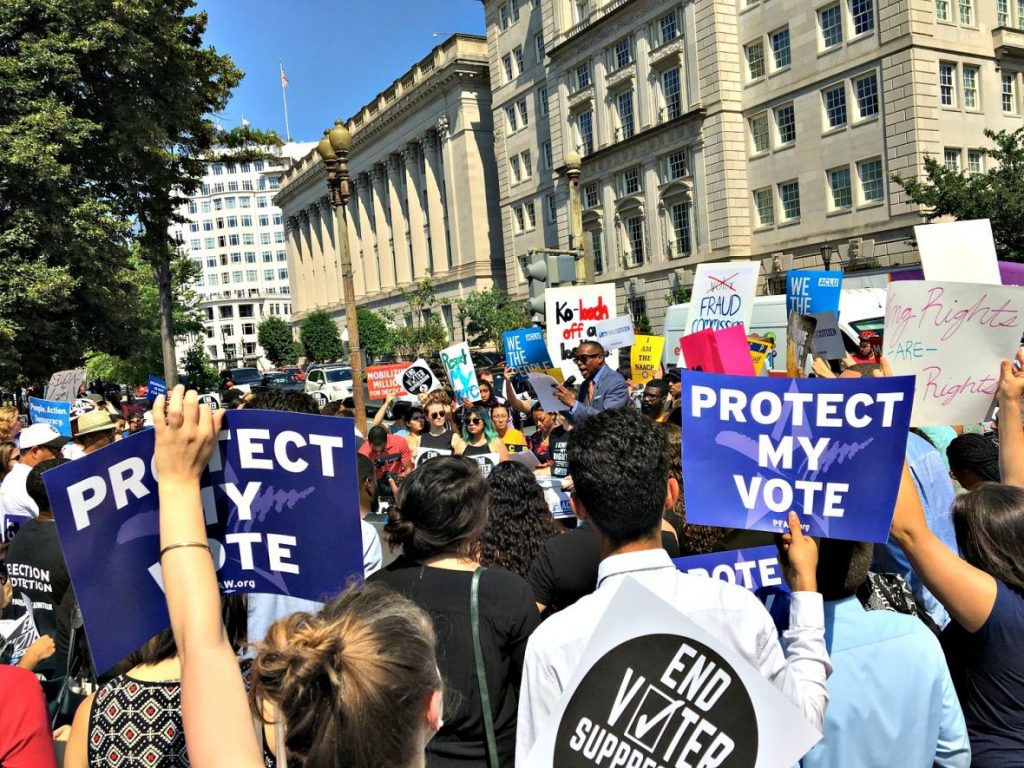- Like
- Digg
- Del
- Tumblr
- VKontakte
- Buffer
- Love This
- Odnoklassniki
- Meneame
- Blogger
- Amazon
- Yahoo Mail
- Gmail
- AOL
- Newsvine
- HackerNews
- Evernote
- MySpace
- Mail.ru
- Viadeo
- Line
- Comments
- Yummly
- SMS
- Viber
- Telegram
- Subscribe
- Skype
- Facebook Messenger
- Kakao
- LiveJournal
- Yammer
- Edgar
- Fintel
- Mix
- Instapaper
- Copy Link
by Kathy Stoltz & Julie Archer for the League of Women Voters of WV (LWVWV)
In response to news reports that more than 67,000 voters had been removed from West Virginia’s voter registration rolls since January, Kathy Stoltz represented LWVWV at a meeting with Secretary of State Warner’s elections division staff, along with representatives of WV Citizen Action Group and the ACLU of WV, to learn more about the process for removing voters from the rolls, and the reasons for their removal. The Wood County League also met with Wood County Clerk Mark Rhodes to discuss the voter registration purge and the Presidential Election Integrity Commission. Rhodes is a member of the Commission, which has been tasked by President Trump with looking into allegations of election fraud.
VOTER REGISTRATION PURGE
The Secretary of State and county clerks rely on various processes and procedures to guide them in keeping the voter rolls up to date. West Virginia election laws are spelled out in state code, and are subject to the National Voter Registration Act (NVRA). Several in-state and multi-state databases are used to identify the deceased and registrants who are not eligible to vote due to a felony conviction or having registered in another county or state. Among them are lists from the Division of Corrections, the Social Security Administration’s Death Master File (DMF), and National Change of Address (NCOA) system. West Virginia is also a member of the Electronic Registration Information Center (ERIC), a multistate partnership that enables states to share and compare official data on eligible voters in order to keep voter rolls more complete and up to date. ERIC is owned, managed, and funded by participating states with assistance from The Pew Charitable Trusts. Comparing these lists to West Virginia’s statewide registration list identifies those whose registrations possibly are invalid.
Voter registrations are identified in several categories:
“Active” voters are those whose registrations are up to date and who have voted in any election within the last four years (the span of two presidential elections).
“Inactive” voters are those who have not voted in the last four years or whom election officials believe may no longer be eligible because they have moved. These voters will have been sent a notice asking that they confirm or update their registration information. If the person does not respond to the notice or the US Postal Service returns the notice as non-deliverable, then the voter is considered “inactive.” Their information will still appear on the county voter lists and poll books, but to be returned to “active” status they will have to update their information or confirm that it is correct, which they can do by contacting their county clerk or going to the polls to vote and updating it there. “Inactive” voters who fail to respond to the notice or otherwise update their registration and do not vote in the next two federal elections will have their registration “cancelled.”
During a “purge”, registrations of those who are confirmed through the various databases to be no longer eligible to vote are “cancelled.” This would include deceased people, felons who have not completed their sentences, people found to be registered and voting in another jurisdiction, etc. After a voter’s registration is “cancelled” they are removed from the county voter lists and poll books, but their names will still appear in the Statewide Voter Registration System (SVRS) for up to 5 years before being permanently deleted (purged).
According to the Secretary of State’s Office, as of September 22 over 73,000 outdated or ineligible registrations been “canceled” since Secretary Warner took office in January. A rough breakdown of those:
- The majority (nearly 44,000) were canceled due to inactivity (not voting for at least 8 years) and failure to respond to a confirmation notice.
- Another 17,000 voters were identified as deceased by county clerks or the SSA’s DMF.
- More than 5,000 had moved out of state.
- Nearly 1,600 were identified as felons by the Department of Corrections.
- The remaining 5,000 were determined to be duplicates or court ordered cancellations due to mental incompetence, etc.
Statewide, 5.77% of registrations have been cancelled, the rate in individual counties ranging from a high of 21.82% to 1.45%. Note that a county having ineligible registrations on its rolls does not mean that those people voted. Of the 732,362 ballots cast in the 2016 General Election, so far the Secretary of State’s Office is pursuing two cases of fraudulent voting, representing less than one-one thousandth of one percent of votes cast. Clearly, this does not represent widespread voting fraud.
The Secretary of State’s Office says it also has worked with county clerks to register nearly 29,000 new voters over the same time period. A breakdown of new registrations v. canceled in each county can be viewed at https://tinyurl.com/CancelledVoters.
It is too soon to tell whether there will be instances of WV voters’ registrations being canceled erroneously. Voters can confirm their own registration online at https://services.sos.wv.gov/Elections/Voter/AmIRegisteredToVote or by contacting their county clerk. If a voter finds that they are not on the rolls when they go to vote and they believe they are registered, they are entitled to vote a provisional ballot.
PRESIDENTIAL ELECTION INTEGRITY COMMISSION (PEIC)
The LWVUS is on record opposing the PEIC, also known as the Pence-Kobach Commission, out of concern that the Commission is not genuinely seeking to preserve and promote voter participation and election integrity but is unjustifiably and inappropriately collecting information about voters in order to suppress the vote. Several of its members have a history of favoring voter suppression measures and seem determined to find voting fraud where it does not exist. Information about the 12 members of the PEIC is available at: https://www.brennancenter.org/analysis/meet-members
In July the LWVWV sent a letter to Secretary of State Mac Warner expressing our concerns about the Commission and its attempt to collect personal information on every US voter, and urged the Secretary not to cooperate. Ultimately, Warner’s office responded to the Commission’s request saying, “A request for voter registration information will be considered by submitting the required documentation and the fees associated with the list. We will not release personal information to the Presidential Commission, even upon request.” To our knowledge, no formal request has been received from the Commission.
The Commission has held two meetings. According to media accounts, the first meeting focused on fraud rather than access to the polls, and seemed to downplay the risks posed by hacking. For its second meeting, the Commission had “a packed agenda with panels reinforcing their goal of voter suppression,” according to the LWVUS. Both meetings received a high level of scrutiny from voting rights advocates, including the League.
The five Democratic members of the twelve-member Commission have been pressured to resign. Wood County Clerk Mark Rhodes told the LWV of Wood County that he feels it is important to have their views and concerns represented. Among these are concern about election processes that can be addressed in the Commission’s recommendations, such as requiring that all election equipment include a paper trail (not all states require this) and that a system be developed for notifying state election officials that hacking of some part of their registration or voting systems has been attacked, which was not in place for the 2016 election.
The Commission’s report on its findings is due May 11, 2018. The League and allies will continue to monitor their activities.
This article was written for the Fall 2017 edition of the Voter published by the LWVWV.

